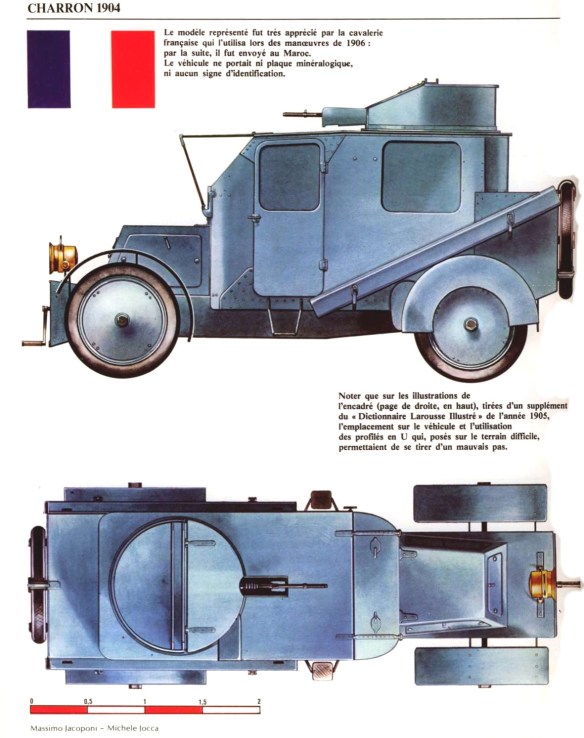Two Charron partly armoured cars were built in France in 1904, based on saloon car bodies. A hand-traversing machine gun turret was fitted on the roof over the rear seats. One was purchased by the Russians and the other was used by the French in Morocco.
In 1902 when the Charron, Giradot et Voigt company exhibited at the Salon de l’Automobile in Paris a car with a circular shield of armour plate instead of the rear seats and within it a pedestal mounting for a Hotchkiss machine gun. A French Army commission carried out firing trials with it in 1903 but saw no need for such a vehicle.
Nevertheless, Charron, Giradot et Voigt continued to work on the development of an armoured car in collaboration with the Hotchkiss company and Major Guye of the French Artillery, whose patented turret it incorporated. The resulting vehicle was still based on a passenger car chassis but it had a fully armoured body surmounted by a turret with a Hotchkiss machine gun. It came to weigh about 3 tonnes and was capable of a road speed of 45km per hour.
The new vehicle was ready by the beginning of 1906 when it was inspected by the French minister of war. This was followed by tests during the autumn manoeuvres of the French Army, but a commission that reviewed reports on the vehicle as well as other new developments concluded in May 1909 that armoured cars should not be considered further because they could not move over all types of terrain and because of their high production cost. Moreover, the French cavalry preferred unarmoured machine gun cars.
Nakashidze-Charron was the first Russian armored car. It was designed by M.A. Nakashidze in 1905. It had a single turreted machine gun and was armored with 3mm steel plate. After the design was accepted by the War Ministry, the French firm Charron, Girardot & Voigt at Puteaux near Paris was contracted to build the prototype since the Ministry decided that the Russian industry of that period was not capable of producing such a vehicle. After the prototype was completed, trials conducted on the vehicle during the summer wargames of 1906 yielded positive results.
The War Ministry ordered the production of ten more vehicles. The French firm completed these vehicles in 1908 but only eight arrived in Russia. The Germans claimed that the other two vehicles were “lost” in their rail transit through Germany. The two stolen vehicles were spotted during the Landwehr maneuvers. One of these vehicles was still in France when the First World War broke out in 1914. It was immediately requisitioned by the French authorities and sent into battle but only to be quickly lost.
Nakashidze’s armoured car.
In keeping with the other armies of the time, the horse provided transport for all arms in the Tsarist Army, although as early as 1905 attempts were being made to provide the cavalry with armoured cars for use in the war against Japan. Shortly after the outbreak of the war the Cossack body of the Manchurian Army in Siberia, under Nakashidze, completed the design of an armoured car project, but in spite of the support given by the Commander of the Manchurian Army, General Linevich, the War Department refused to undertake the project in Russia. Nakashidze’s drawings were, however, despatched to France, where the construction of his armoured car was undertaken by the firm of Charron Girardot et Voigt. The initial order for 36 vehicles was, reluctantly, reduced to one, and in 1905 the completed vehicle was delivered to the Russians. Designed from experiences in combat in Manchuria, the vehicle proved to be of exceptionally good design. It had a large ground clearance and the wheels were protected by armoured discs as opposed to the contemporary use of wooden spoked wheels. A portable bridging device facilitated overcoming obstacles, such as trenches, up to 3 metres in width. A machine-gun was mounted in a revolving turret, and another stowed within the vehicle. The armour was 4-5 mm thick, giving the car a combat weight of 3 tons. Its maximum speed was 50 kph.
In 1905, Nakashidze submitted an official report to the War Department wherein he requested an official trial for evaluating the possible future value of armoured cars in the Russian Army. Following this, in 1906, a trial was carried out with experimental armoured cars, moving along all types of road and across dry, arable land, on a route from St Petersburg via Oranienbaum (now Lomonosov) to Venki. Experimental machine-gun firing was carried out at the Imperial Officer School firing range. Both stationary and mobile firing trials were conducted at the school under the supervision of Filatov, the Chief Range Officer at the Oranienbaum School. The results of these firing trials were very favourable, and an armoured car was subsequently entered in the Krasnoseliskikh manoeuvres during July 1906. The commission who tested the car stated that it was of great value for reconnaissance in the rear and flanking areas of the enemy, for liaison between fronts, for disordering attacking enemy cavalry, for partisan work and in the pursuit. The Commission stated that:
The armoured car has a wide future as a supporting means of combat.
Following this evaluation, it was proposed to redesign and improve the armoured car at the Izhorski Zavod, but although supported by the General Staff, the proposal was turned down by the War Department.
